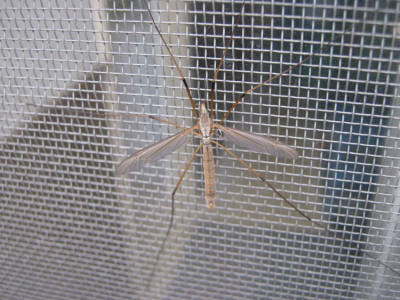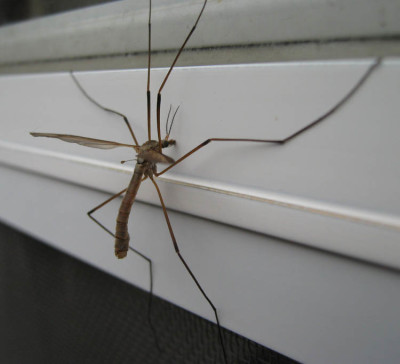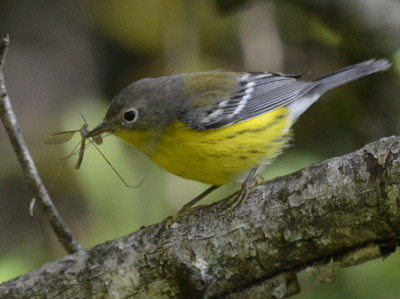Here in southern Ontario, in the fall and sometimes in the spring, we often find huge insects that look vaguely like mosquitoes perched clumsily on the screen doors of our home. When we go to mow the lawn, there are more of them sitting on the grass and lurching clumsily into the air as we walk. They don’t bite, sting or otherwise attack but they still remind most people of gigantic mosquitoes. What are they really?
Crane Flies are Clumsy Fliers
They are called Crane Flies probably because their long gangly legs reminded someone of crane birds. There are several native types in North America and many of them seem to like perching on screens judging by the photos submitted to BugGuide.net! More recently, in Ontario an invasive species called the European Crane Fly has tottered onto the scene. They likely arrived in contaminated soil from Europe or the Maritimes.
What Do Crane Flies Eat?
Generally speaking, most adult Crane flies don’t eat. Some species apparently do eat nectar but I’ve never seen our local Ontario varieties on blossoms.
They do eat before they transform into adult flying insects. In their youthful stage they look vaguely like a caterpillar or a chrysalis. The common name for this larval stage is “leatherback.”
According to the Mississauga Pest Control website (http://www.mississaugapestcontrol.ca/Pests/European-Crane-Fly-or-LeatherJackets.html), one of the species in southern Ontario is the introduced European Crane Fly. Its larvae feed on grass leaves and grass roots. The damage is minor however and lawns quickly recover.
According to the Region of Peel website, the larvae of the European kind emerge at night and feed on the grass leaves sometimes eating them right down to the top of the soil, leaving bald patches.
Other species larvae have been known to be aquatic and to feed on mosquito larvae. Go Crane flies!
The larvae can be quite big. When fully grown, European Crane fly larvae can be 4 cm long, according to the Ontario Ministry of Agriculture website.
When do Adult Crane Flies Emerge
Also according to the Ontario Ministry of Agriculture website, European Crane flies become winged adults usually in September. They mate and lay eggs almost immediately. The eggs hatch in about 2 weeks and the larvae live under the grass. They feed until about May or June, then stop which allows lawns to recover. Newly hatched larvae have a poor chance of survival on dry grass. So I guess watering less may help if they are bothering you!
Another species, which I think must be native as I can’t find anything to say otherwise, emerges as an adult in May.
A survey in 2004 in New York state found 2 native species of Crane flies and one invasive species. Several websites mention that some of the native species prefer to eat dead vegetation and leaves.
What Eats Crane Flies?
One thing that has always puzzled me is whether anything actually eats crane flies. They certainly are easy to catch. They fly slowly and awkwardly and are often perched on the grass.
This week at the Rattray Marsh I discovered that warblers, at least, do eat them. This is a Magnolia Warbler who briskly caught this fly, bashed it a few times against the branch, then ate it.
Again, according to the OMA website birds also eat the larvae from the grass. In fact they suggest watching where crows feed on golf courses to determine where there is an infestation!
Crane Flies: Mostly Harmless
So in the words of Douglas Adams, Crane Flies are “mostly harmless.”
Related Reading
- Falling for Fall Magnolia Warblers
- Western Conifer Seed Bug Seeks Snug Warm Winter Home in Mississauga Ontario
Join In
Do you mind having Crane Flies appearing on your windows and doors in the cool fall mornings? Or do they seem vaguely comical to you and bring a smile? Please share your views with a comment.




Its Dec 22 and Just found one in my kitchen in Stouffville Ontario. It was -20C two weeks ago. I also brought in some plants from the balcony in the fall. My question is did this one appear from outside or was hiding – or did it just emerge from the asparagus fern plant that was outside all summer. Given if it’s the the later I’m wondering if there will be more coming soon!
How intriguing! I really don’t know where your Crane came from but it is possible it was in the pot. I noticed on BugGuide there are also some similar insects called Winter Crane Flies https://bugguide.net/node/view/8522 but they don’t look quite the same.
I’ll hope you only have the one guest inside and thanks for sharing your sighting!